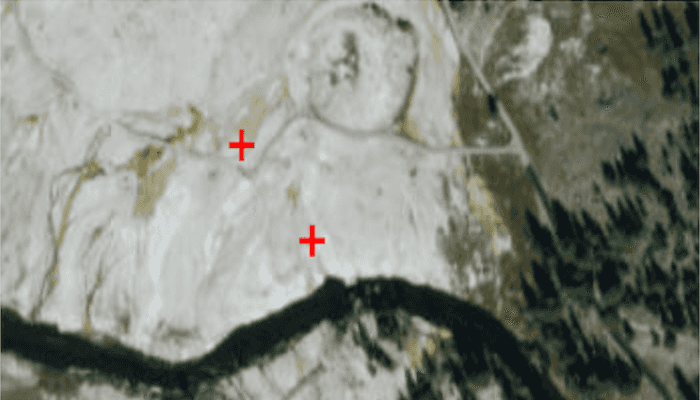Display common symbols for all graphics in a graphics overlay with a renderer.

Use case
Graphics are often used to display data that changes location regularly because they are held in memory instead of being persisted to the map. When a number of graphics are required to share the same style, a simple renderer can be applied to the graphics overlay containing the graphics. For example, the location of mobile taxis from a same company could be plotted on a map with each taxi marked by a relevant symbol.
How to use the sample
The sample loads with a predefined simple renderer, which displays a red cross simple marker symbol for the graphics in the graphics overlay.
How it works
- Create a
GraphicsOverlay. - Create a number of
Pointobjects with x, y and spatial reference parameters. - Create a
SimpleMarkerSymbolpassing in aSimpleMarkerSymbol.Style, color and size as parameters. - Create a simple renderer with
SimpleRenderer(simpleMarkerSymbol). - Set the simple renderer to the graphics overlay using
graphicsOverlay.setRenderer(simpleRenderer). - Create a number of
Graphicobjects with the points initiated in step 2. - Add the graphics to the graphics overlay with
graphicsOverlay.getGraphics().add(graphic).
Relevant API
- Graphic
- GraphicsOverlay
- Point
- SimpleMarkerSymbol
- SimpleRenderer
Additional information
Renderers are used to display graphics that don't already have a symbol set. A renderer will not override a graphic's symbol if one has been set.
Tags
graphics, marker, renderer, symbol, symbolize, symbology
Sample Code
/* Copyright 2016 Esri
*
* Licensed under the Apache License, Version 2.0 (the "License");
* you may not use this file except in compliance with the License.
* You may obtain a copy of the License at
*
* http://www.apache.org/licenses/LICENSE-2.0
*
* Unless required by applicable law or agreed to in writing, software
* distributed under the License is distributed on an "AS IS" BASIS,
* WITHOUT WARRANTIES OR CONDITIONS OF ANY KIND, either express or implied.
* See the License for the specific language governing permissions and
* limitations under the License.
*
*/
package com.esri.arcgisruntime.sample.simplerenderer;
import android.graphics.Color;
import android.os.Bundle;
import androidx.appcompat.app.AppCompatActivity;
import com.esri.arcgisruntime.ArcGISRuntimeEnvironment;
import com.esri.arcgisruntime.geometry.Envelope;
import com.esri.arcgisruntime.geometry.Point;
import com.esri.arcgisruntime.geometry.SpatialReferences;
import com.esri.arcgisruntime.mapping.ArcGISMap;
import com.esri.arcgisruntime.mapping.BasemapStyle;
import com.esri.arcgisruntime.mapping.view.Graphic;
import com.esri.arcgisruntime.mapping.view.GraphicsOverlay;
import com.esri.arcgisruntime.mapping.view.MapView;
import com.esri.arcgisruntime.symbology.SimpleMarkerSymbol;
import com.esri.arcgisruntime.symbology.SimpleRenderer;
public class MainActivity extends AppCompatActivity {
MapView mMapView;
@Override
protected void onCreate(Bundle savedInstanceState) {
super.onCreate(savedInstanceState);
setContentView(R.layout.activity_main);
// authentication with an API key or named user is required to access basemaps and other
// location services
ArcGISRuntimeEnvironment.setApiKey(BuildConfig.API_KEY);
//Create points to add graphics to the map to allow a renderer to style them
//These are in WGS84 coordinates (Long, Lat)
Point oldFaithfullPoint = new Point(-110.828140, 44.460458, SpatialReferences.getWgs84());
Point cascadeGeyserPoint = new Point(-110.829004, 44.462438, SpatialReferences.getWgs84());
Point plumeGeyserPoint = new Point(-110.829381, 44.462735, SpatialReferences.getWgs84());
//Use the farthest points to create an envelope to use for the map views visible area
Envelope initialEnvelope = new Envelope(oldFaithfullPoint, plumeGeyserPoint);
// inflate MapView from layout
mMapView = findViewById(R.id.mapView);
// create a map with the imagery basemap. This will set the map to have a WebMercator spatial reference
ArcGISMap map = new ArcGISMap(BasemapStyle.ARCGIS_IMAGERY);
// set the map to be displayed in the mapview
mMapView.setMap(map);
//set initial envelope on the map view sith some padding so all points will be visible
//This envelope is using the WGS84 points above, but is reprojected by the mapview into the maps spatial
// reference, so its works fine
mMapView.setViewpointGeometryAsync(initialEnvelope, 100);
// create a new graphics overlay and add it to the mapview
GraphicsOverlay graphicOverlay = new GraphicsOverlay();
mMapView.getGraphicsOverlays().add(graphicOverlay);
//[DocRef: Name=Simple Renderer, Category=Fundamentals, Topic=Symbols and Renderers]
//create a simple symbol for use in a simple renderer
SimpleMarkerSymbol symbol = new SimpleMarkerSymbol(SimpleMarkerSymbol.Style.CROSS, Color.RED,
12); //size 12, style of cross
SimpleRenderer renderer = new SimpleRenderer(symbol);
//apply the renderer to the graphics overlay (so all graphics will use the same symbol from the renderer)
graphicOverlay.setRenderer(renderer);
//[DocRef: END]
//create graphics from the geyser location points. NOTE: no need to set the symbol on the graphic because the
// renderer takes care of it
//The points are in WGS84, but graphics get reprojected automatically, so they work fine in a map with a spatial
// reference of web mercator
Graphic oldFaithfullGraphic = new Graphic(oldFaithfullPoint);
Graphic cascadeGeyserGraphic = new Graphic(cascadeGeyserPoint);
Graphic plumeGeyserGraphic = new Graphic(plumeGeyserPoint);
graphicOverlay.getGraphics().add(oldFaithfullGraphic);
graphicOverlay.getGraphics().add(cascadeGeyserGraphic);
graphicOverlay.getGraphics().add(plumeGeyserGraphic);
}
@Override
protected void onPause() {
super.onPause();
// pause MapView
mMapView.pause();
}
@Override
protected void onResume() {
super.onResume();
// resume MapView
mMapView.resume();
}
@Override
protected void onDestroy() {
super.onDestroy();
mMapView.dispose();
}
}